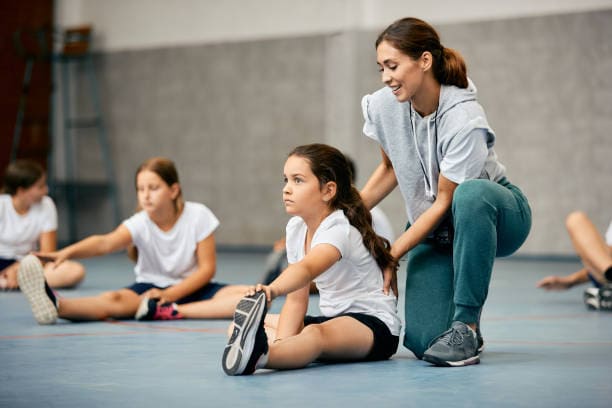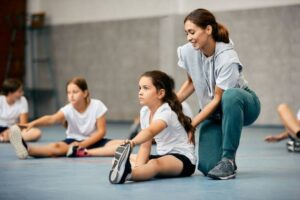The Word ‘Supervision’ Shouldn’t Get a Bad Rap. Here’s Why
Kim (Kimberly) Morrison Kazmierczak is an elementary principal in Council Bluffs, Iowa. Ann Mausbach is an associate professor for educational leadership at Creighton University.
Power. Why do we only feel comfortable using this word when we are in the gym? Or when listening to that catchy toon by Snap! that plays at every sporting event to hype up the crowd, “I’ve got the power”?
For many of us, it is because this word has a negative connotation. Unfortunately, this stems from our relationship with it in the workplace. Our boss, the person who supervises our work, has the power to determine whether we are gainfully employed. This kind of positional power, “power over,” conjures up feelings of fear and helplessness. It can leave us constantly wondering whether we are measuring up. A veteran teacher expressed it this way, “When the principal enters my room, I am being graded, and there are serious consequences for not meeting expectations.”
As a principal, failing to recognize and own that you have power can perpetuate its negative use. Power in and of itself is not a bad thing; it’s how it is used that makes it dangerous (Brene Brown, 2020).
The Rev. Martin Luther King Jr. defined power as “the ability to achieve purpose and effect change.” Embracing this definition requires us to shift our thinking away from power over to power with, power to, and power within. Moving in this direction requires us to differentiate between these types of power.
It is difficult, if not impossible, to motivate teachers by exerting “power over.” Principals must create the conditions in schools where power is used to achieve purpose and create change. The fundamental purpose of schooling is student learning, so those who work most closely with students—teachers—must have power with/to and within to achieve this mission. Supporting teachers in developing this power requires an examination of beliefs and practices around supervision.
Supervision is an experience that should be engaged in with the teacher with the sole intent of helping them help their students. Rather than a way to grade job performance (power over), supervision allows the leader to work alongside (power with) teachers helping them access and build upon techniques that impact student learning. Observations are opportunities to have another set of eyes in the classroom so that afterward rich conversations can ensue that help bring clarity to the classroom issues at hand.
Power within is instilled when the focus shifts to creating a culture where teachers examine practice, work together to solve problems, and constantly refine their work. Power within is nurtured when feedback allows teachers to self-reflect and self-analyze what is working and what isn’t. Very little of this can happen when supervision is treated as an isolated event that is driven by compliance and lengthy forms. Instead, a model for supervision is needed that differentiates support based on teacher needs and supervision practices (Mausbach & Morrison, 2022).
Differentiated supervision embraces a philosophy that is designed to instill power to/with and within teachers. It does this by matching the level of supervision with the needs of both individuals and teams while moving the entire school forward. Ongoing meaningful feedback serves as the centerpiece for this approach so teachers and leaders can work together to develop a mutual understanding about what students need to succeed.
Differentiation by teacher means knowing, understanding, and responding to the unique needs of individual teachers. No two teachers’ needs are exactly the same, so supervision practices that treat them as such miss the mark. Feedback tools in the differentiated-supervision model help pinpoint areas of support so individual teachers and the principal can engage in meaningful dialogue about how to help students, nurturing and supporting their power within.
Differentiated supervision also means using a variety of methods to provide support to teachers. Multiple methods are used to help the leader develop an in-depth understanding of students’ and teachers’ needs. A mixture of supervisory practices (i.e., general walk-throughs, implementation studies, etc.) help the leader take a diagnostic stance about what is working and what isn’t throughout the school. This information is useful when teams are working together to address teaching and learning issues. An all-hands-on deck approach is the tenor of team meetings, which develops “power with,” a necessary ingredient in collective teacher efficacy.
Rather than eliciting feelings of dread or ambivalence, supervision can be an empowering experience that increases teachers’ agency and self-efficacy. Differentiating supervision makes this happen and helps leaders abandon the “power over” mentality, replacing it with power with/to/within. Embracing power, our ability to achieve purpose and create change is worth the hype as culture and achievement will improve. And just like a stadium of rowdy basketball fans, it will have your teachers enthusiastically agreeing with the anthem “I’ve got the power!”
How A Texas Teen Turned Bias and Body-Shaming into Advocacy and Action
Olivia Julianna (who uses only her first and middle name publicly to protect her privacy) has been an activist for several years, advocating voting rights and reproductive-health care. Like many in her generation, she found the political side of TikTok where young people post about important issues facing them. Olivia is involved with Gen-Z for Change, a nonprofit organization leveraging social media to promote civil discourse and political action on a variety of topics including COVID-19, climate change, systemic inequity, foreign policy, voting rights, and LGBTQ+ issues.
The online targeting of Olivia started after she criticized an elected official who, at a student-action summit in Florida, called abortion-rights activists disgusting and overweight and said, “No one wants to impregnate you if you look like a thumb” among other offensive comments. After Olivia denounced these comments, the politician then posted a photo of her on Twitter next to an article that referenced his insults. That picture went far and wide to his million-plus followers. In addition, she received hateful and biased private messages.
Online hate and harassment are all too common, especially for those in marginalized identity groups like Olivia who is a queer, Latina woman—identity groups that are often targeted in digital spaces. While ignoring, muting, blocking, documenting, and reporting are all options, Olivia decided to address the bias and offensive comments directly. That’s when she engaged in a public social media battle with the elected official, who continued to double down on body-shaming and belittling her.
As a result, Olivia announced she would be supporting a fundraising campaign for the Gen-Z for Change Abortion Fund, which splits donations across abortion funds in all 50 states. This story instantly exploded on social media. Although the number of offensive comments she received increased, she also received overwhelming support, so much so it also brought more criticism but also helped Olivia raise $2.2 million—which is still climbing. She’s inspired people in Texas, elsewhere in the U.S., and beyond. She says, “I’ve been mocked, ridiculed, and harassed for most of my life. I will not tolerate that kind of behavior anymore. Don’t mess with Texas women and don’t underestimate Gen Z!”
For educators and those who work with young people, especially as we return to school in what promises to be another challenging school year, what can we take away from Olivia Julianna’s experience and story?
Teach young people about current real-life activists and others who take action about bias and injustice. Even better if those activists are young people themselves because people like Olivia Julianna can serve as important role models. Civil rights activists of the past are icons in history, and we should teach about them. However, if we also highlight current activists who are young, they will be able to see themselves in that advocacy. You can use children’s literature, current events, and social studies text to explore activism with young people.
Help young people consider what problems and injustices they currently see in their world. Then, as Olivia did, help them transform those concerns into actions. As Bellen Woodard, who dubbed herself the “World’s 1st Crayon Activist” at 8 years old, suggests in More than Peach, her new picture book, “Instead of asking kids what they want to be when they grow up, ask them what they want to change.” What we can learn from Bellen, Olivia, and other young activists is how vital it is we talk with young people early and often about how they want to make a difference in their world.
Don’t just tell young people to challenge bias and bullying—show them how. This means helping them understand and identify what bias and injustice are and then providing tools and practice for them to address and challenge the injustice. Discern the difference between addressing it in person and in digital space because young people are increasingly facing bias and harassment online. Teach them the skills of allyship and the many ways one can act as an ally, advocate, and activist.
Explore with young people the myriad ways they can engage in activism. Olivia showed us a variety of strategies, from educating to organizing to fundraising. Many young people, and adults, are taught that activism is only about protesting. It’s important to show them that as there are many ways to be an ally, there are many ways to engage in activism such as educating others, running for office, raising funds, advocating legislation, and more.
Remember that many young people will not take action when faced with bias and bullying. In fact, many young people will turn inward and may not tell anyone. Young people are reluctant to report bias and bullying to adults, and that reluctance increases with age. As a school staff, explore how you can be more approachable so that students are more likely to tell you when something is happening. Make sure your school’s bullying, harassment, and nondiscrimination polices are current, reflect district and state guidelines, and include clear definitions and consequences, incorporating online behavior as well.
It’s a difficult world out there right now. From health care to climate change to racism to gun violence, young people are facing many issues in their lives, issues that are sure to challenge their future. We can help them navigate these choppy waters by showing them and inspiring them to do something about the injustice they see in their world. Olivia Julianna’s story is instructive and can help show the way.


Leave a Reply